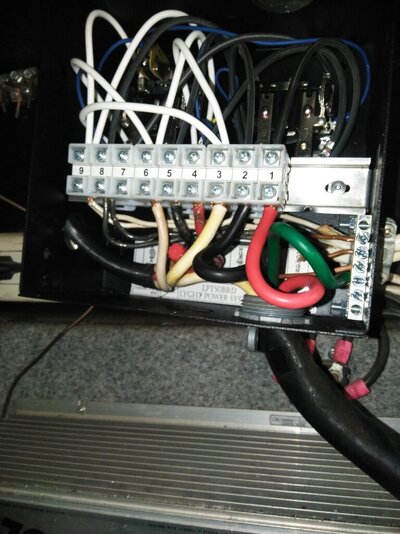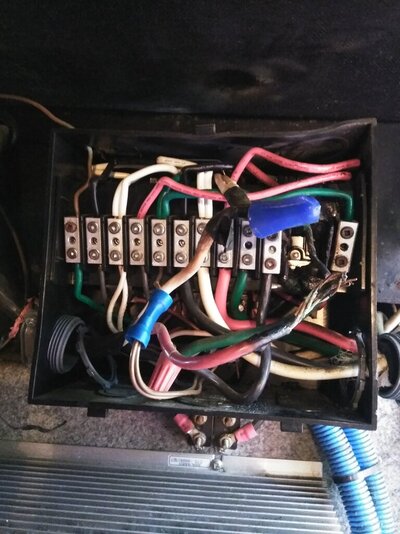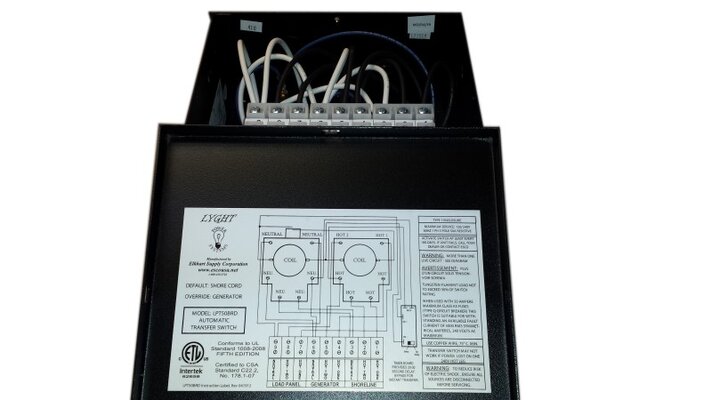3rd Gen Army
Member
Mostly in great shape, but a few issues so far - generator was running rough and kept shutting off. I serviced it with new plugs, fuel filter and fuel pump, complete oil change and filter, and cleaned air filter area and changed it. Ran great. Hooked to shore power to conserve gas. Didn't have hot water, found out the anode was completely gone, cleaned tank of all the sediment and a new rod, have hot water.
Then the major problem showed up. Went to sleep and woke up sweating, figured we blew a fuse, went back to sleep. Woke up in the morning and checked, nope - our ITS-50R automatic transfer switch had burnt wires and melted completely in several areas. Ok, called a mobile service guy out. He didn't seem to know what he was talking about. I have a 50amp, 120, 240 switch. He told me I only had to have a 50 amp, 120v switch, I didn't need the 240v. I have 2 air conditioners and a washer/dryer. He argued and said I didn't need it, my cord was only 110v. Never saw a cord with a 2 inch diameter and 4 prongs. It has adapter's to go down to 110v. Having been in the Army as a mechanic, I also learned how to work on generators from necessity while in Iraq from 2002-2003. I've also learned electrical repair on my own. I've never been afraid to tackle anything. Besides, I have Google search.
I heard back from the mobile repair, still said I didn't need the 240v and it would be $300 for the switch, plus the call of $75 and the diagnostic of $75, plus putting it in. So I found one for $230. I ordered it and put it in. I have it all hooked up but no power to the coach from shore power or the generator. I've checked my fuses and the wiring, seems like it's correct, so turning to you all for some much needed advice.
What do I need to check to get it working? There are so many fuses and I don't know if I'm missing anything.
I have the normal black, white, red, and green wires for the shore power and the generator, but the coach has two sets of wires that are black, white and ground. I placed the two black wires together and the two white wires together and attached the two ground wires separately.
What do I need to do?
Then the major problem showed up. Went to sleep and woke up sweating, figured we blew a fuse, went back to sleep. Woke up in the morning and checked, nope - our ITS-50R automatic transfer switch had burnt wires and melted completely in several areas. Ok, called a mobile service guy out. He didn't seem to know what he was talking about. I have a 50amp, 120, 240 switch. He told me I only had to have a 50 amp, 120v switch, I didn't need the 240v. I have 2 air conditioners and a washer/dryer. He argued and said I didn't need it, my cord was only 110v. Never saw a cord with a 2 inch diameter and 4 prongs. It has adapter's to go down to 110v. Having been in the Army as a mechanic, I also learned how to work on generators from necessity while in Iraq from 2002-2003. I've also learned electrical repair on my own. I've never been afraid to tackle anything. Besides, I have Google search.
I heard back from the mobile repair, still said I didn't need the 240v and it would be $300 for the switch, plus the call of $75 and the diagnostic of $75, plus putting it in. So I found one for $230. I ordered it and put it in. I have it all hooked up but no power to the coach from shore power or the generator. I've checked my fuses and the wiring, seems like it's correct, so turning to you all for some much needed advice.
What do I need to check to get it working? There are so many fuses and I don't know if I'm missing anything.
I have the normal black, white, red, and green wires for the shore power and the generator, but the coach has two sets of wires that are black, white and ground. I placed the two black wires together and the two white wires together and attached the two ground wires separately.
What do I need to do?



